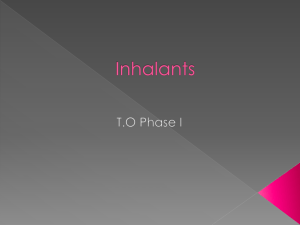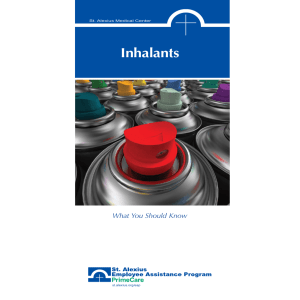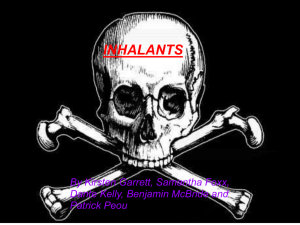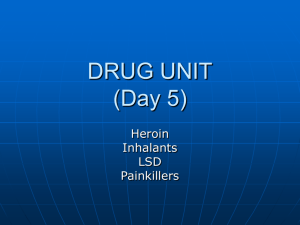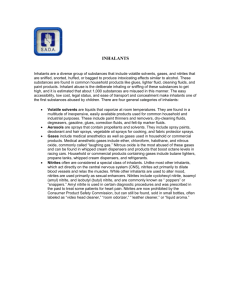File - Kory Maw's ePortfolio
advertisement
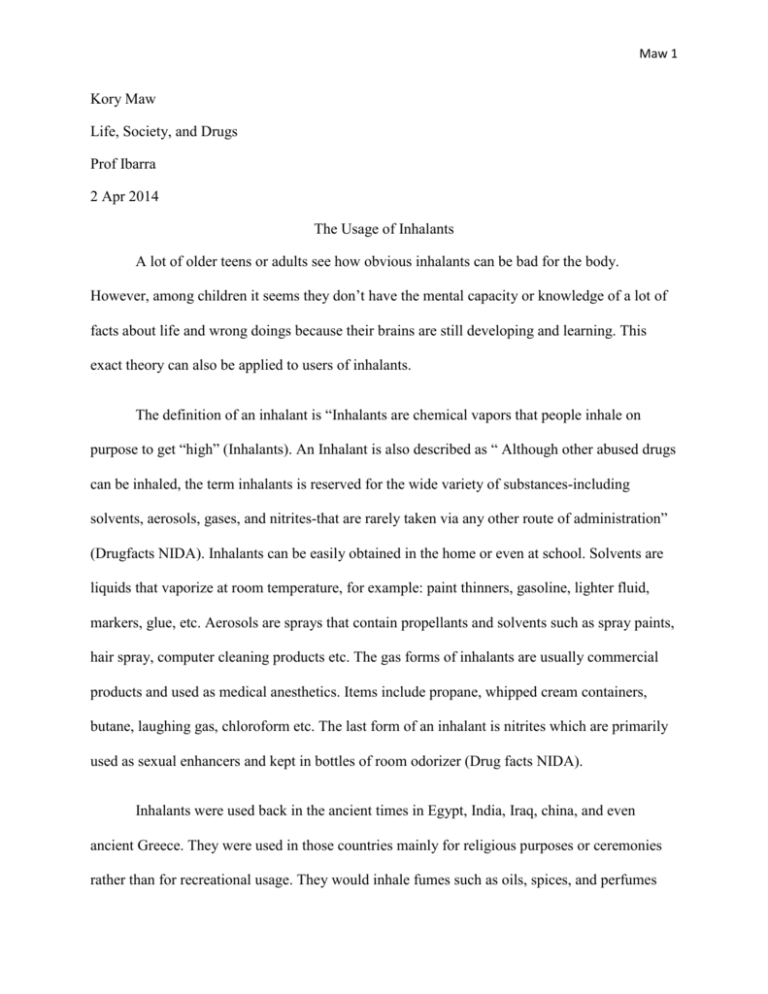
Maw 1 Kory Maw Life, Society, and Drugs Prof Ibarra 2 Apr 2014 The Usage of Inhalants A lot of older teens or adults see how obvious inhalants can be bad for the body. However, among children it seems they don’t have the mental capacity or knowledge of a lot of facts about life and wrong doings because their brains are still developing and learning. This exact theory can also be applied to users of inhalants. The definition of an inhalant is “Inhalants are chemical vapors that people inhale on purpose to get “high” (Inhalants). An Inhalant is also described as “ Although other abused drugs can be inhaled, the term inhalants is reserved for the wide variety of substances-including solvents, aerosols, gases, and nitrites-that are rarely taken via any other route of administration” (Drugfacts NIDA). Inhalants can be easily obtained in the home or even at school. Solvents are liquids that vaporize at room temperature, for example: paint thinners, gasoline, lighter fluid, markers, glue, etc. Aerosols are sprays that contain propellants and solvents such as spray paints, hair spray, computer cleaning products etc. The gas forms of inhalants are usually commercial products and used as medical anesthetics. Items include propane, whipped cream containers, butane, laughing gas, chloroform etc. The last form of an inhalant is nitrites which are primarily used as sexual enhancers and kept in bottles of room odorizer (Drug facts NIDA). Inhalants were used back in the ancient times in Egypt, India, Iraq, china, and even ancient Greece. They were used in those countries mainly for religious purposes or ceremonies rather than for recreational usage. They would inhale fumes such as oils, spices, and perfumes Maw 2 that would alter their consciousness for their religious ceremonies. Nitrous oxide and ether then became popular in the 1800’s and on to the 1900’s had continued to be used as a recreational use, especially in the prohibition era where alcohol was absent, so some drinkers went to inhalants to get their needs. As the usage of inhalants grew, in the 1940’s gasoline was introduced and used. In the 1960’s the usage of using commercial products such as paint, paint thinners, nail polish remover, shoe polish, etc. became popular to sniff. The most common way of using inhalants is called “huffing”. Huffing is when users will breathe in the source through a rag and stuffed to the mouth to breathe in or through a bag. Users can sniff right from the source to the nose or mouth such as markers, or glues. Users will also inhale the product from a balloon, or even spray the product into a paper bag and inhale the fumes through the mouth which is called bagging (Inhalants). The types of items themselves can get a nickname that makes it known to other that is it used as a high such as, Whippets are found in the whipped cream dispensers. Other nicknames from inhalants from aerosols, nitrites and solvents can also be called poppers, snappers, laughing gas, and also bold or rush. These terminologies are used to classify the usage as getting a high, as to the correct purpose it was invented for (Inhalants). The usage of Inhalants or solvents is mainly within children and also the low teens. It varies between seventh to twelfth graders. From a study done from the University of Michigan in 2001, they did a survey from eighth grade to twelfth graders in high school; they asked the students if they had ever used inhalants. The report showed a steady decline of users from the eighth graders to the twelfth graders. The percentage of the eight graders was approximately 13 percent, and would drop around 3 percent per grade of the students (Drug facts NIDA). Over half Maw 3 of those users in the 8th grade didn’t think that using it once would be risky and they also didn’t think that continued usage would be harmful to their body. The accessibility of getting inhalants is extremely easy for anyone to get their hands on. They are found throughout the house. Cleaning supplies can be found in most cabinets of the house or bathrooms. Markers, glues, etc. can be found at home or school and easily bought at the local grocery store by anyone. Gasoline and propane can also be found in many people’s garages that could be easily obtained as well. As a natural reaction by most adolescents, the strong or potent odor of the product, usually staring with solvents or aerosols, will lure them in to smell it because they like the smell. After smelling it they may get the immediate results of the high. From the enjoyment of the high of solvents or aerosols, they will get more creative and also want something more potent such as gasses or nitrates that will give a better stronger high. Alcohol and Inhalants are very similar when it comes to how they affect the brain. It also depresses the central nervous system causing slurred speech, lack of coordination, euphoria, and dizziness. But with inhalants they may also experience hallucinations, delusions, and light headedness. When more than one hit is taken, it is very likely that users will feel drowsy for many hours followed by an excruciating headache and will cause addiction. Using inhalants can cause short term effects such as vomiting, nausea, etc. and also long terms effects depend on what classification of inhalant one is using include hearing loss, kidney damage, liver damage, heart issues, bone marrow damage, nerve damage, and also brain damage due to lack of oxygen getting to the brain. Not only can inhalants be damaging organs, but they can also be very lethal when consuming large amounts in a short time period. Within minutes of a high dosage of a potent inhalant it can cause heart failure. It can also cause someone to die by suffocation mainly from inhaling from an enclosed space with minimal oxygen (Drug facts NIDA). Maw 4 When it came to Riley Foster, a seventh grade student in Indianapolis Indiana, was a good student with athletic roles playing in his life, became to feel withdrawn and distant. His first inhalant was a can of duster at a friend’s house. He then liked it so much he kept inhaling. “It’s just kind of like taking your head away from your body” (Salahi) he said. After being introduced to inhalants, he would often spend hours in his garage inhaling gasoline. His family had no idea that he was abusing gasoline as an inhalant until his mom found his passed him completely blacked out from overdosing. “A sixth grader doesn’t have the drug connections that maybe an older student might have, it’s just the curiosity, the naiveté that comes from being young, it’s easy to get, cheap and legal” (Salahi). Like previously stated, huffing can be lethal and can be lethal within minutes after ones first hit or sniff. This exact thing had happened Aaron Hunt, a senior at Mchenry West High School in Wonder Lake Illinois. When the paramedics arrived his heart had already stopped and his brain was going without oxygen for more than ten minutes. He then spent four days on life support when they found out the damage had been way too severe to his brain and removed life support and died. Before this incident, Aaron had been caught smoking marijuana and had to attend counseling and had annual drug tests in which he had passed every time since he quit smoking marijuana. He must have felt like he always needed a high and switched to inhalants. He switched to inhalants because he needed to pass his annual drug tests, and inhalants don’t show up on drug tests, therefore he passed every test and was also getting the high he couldn’t live without (Broundou). Around the country, many cases have been taken of people who know abusers of inhalants or people who were addicted to inhalants by excessive usage that demanded the need of the high from inhalants. Some of their stories are mostly considered to be of addiction or loss of Maw 5 a loved one from the inhalants. Jackie was a parent of an abuser and said this about her son. “Tomorrow is the sixth anniversary of our son Justin’s death. He was sixteen. He died from inhaling air freshener, an act of inhalant abuse. His senseless death rocked the worlds of all who knew him. Justin was an honors student who loved life and embraced it with enthusiasm. (He was a source of inspiration for many.) I will always be haunted by the question of whether Justin would be with us today had he known about the risks he was taking” (Drug Free). Another interesting quote of a user named Erik said the following, “I actually found myself talking to what I call ‘gas buddies’ (the hallucinations). One day I was huffing and I thought my friend died because the hallucination of him came to me. I found myself huffing not only for the visuals, but for the company of these imaginary ‘friends’ that would come to me when I would start to huff. I have been struggling with this addiction for about seven months now” (Drug Free). Over the years, the usage of inhalants has risen among teenagers between seventh grade and twelfth graders. Although it may be logical knowledge to assume breathing strong chemicals would be harmful to one’s body, the results are the exact opposite. Teenagers are turning to inhalants because they are cheap to buy, availability in the house, it isn’t considered to be illegal because they are everyday items used for specific purposes outside of the drug life, and they also don’t show up on drug tests so people who have to take annual drug tests can still get their “high” while doing it in a legal way. Despite the effects of inhalants being very harmful to the brain, liver, kidneys, heart, and it also being lethal won’t stop young teenagers from using inhalants because at this stage in life they have a high sense of curiosity of the unknown. They will also use it to escape reality to help cure their depression, making them feel happy and away from how people see themselves, and also how they see themselves. But going to the extent of using inhalants could ruin their life, and also their family’s way of life. Maw 6 Work Cited Broundou, Colleen. "Death of Illinois Teen Highlights the Dangers of Huffing Inhalants." Finding Dulciea, 26 Sept.2010. Web. 30 Mar. 2014. "Drug Free World-Real Life Stories on Side Effects of Sniffing or Huffing Inhalant Drug Abuse.". Foundation of a Drug Free World, n.d. Web. 30 Mar. 2014. "DrugFacts: Inhalants." National Institute on Drug Abuse (NIDA). The Science of Drug Abuse and Addiction, Sept. 2012. Web. 28 Mar. 2014. "History of Inhalants, Proliferation & Origins: Foundation for a Drug Free World." History of Inhalants, Proliferation & Origins: Foundation for a Drug Free World. Foundation of a Drug Free World, n.d. Web. 01 Apr. 2014. "Inhalants." NIDA for Teens. The Science behind Drug Abuse, Dec. 2012. Web. 30 Mar. 2014. Salahi, Lara, Courtney Hutchison, Anna Wild, Richard Besser, and Md. "Teens Get High with One Household Huff." ABC News. ABC News Network, 08 Apr. 2010. Web. 30 Mar. 2014. Maw 7 Work Cited Broundou, Colleen. "Death of Illinois Teen Highlights the Dangers of Huffing Inhalants." Finding Dulciea, 26 Sept.2010. Web. 30 Mar. 2014. "Drug Free World-Real Life Stories on Side Effects of Sniffing or Huffing Inhalant Drug Abuse.". Foundation of a Drug Free World, n.d. Web. 30 Mar. 2014. "DrugFacts: Inhalants." National Institute on Drug Abuse (NIDA). The Science of Drug Abuse and Addiction, Sept. 2012. Web. 28 Mar. 2014. "History of Inhalants, Proliferation & Origins: Foundation for a Drug Free World." History of Inhalants, Proliferation & Origins: Foundation for a Drug Free World. Foundation of a Drug Free World, n.d. Web. 01 Apr. 2014. "Inhalants." NIDA for Teens. The Science behind Drug Abuse, Dec. 2012. Web. 30 Mar. 2014. Salahi, Lara, Courtney Hutchison, Anna Wild, Richard Besser, and Md. "Teens Get High with One Household Huff." ABC News. ABC News Network, 08 Apr. 2010. Web. 30 Mar. 2014.
